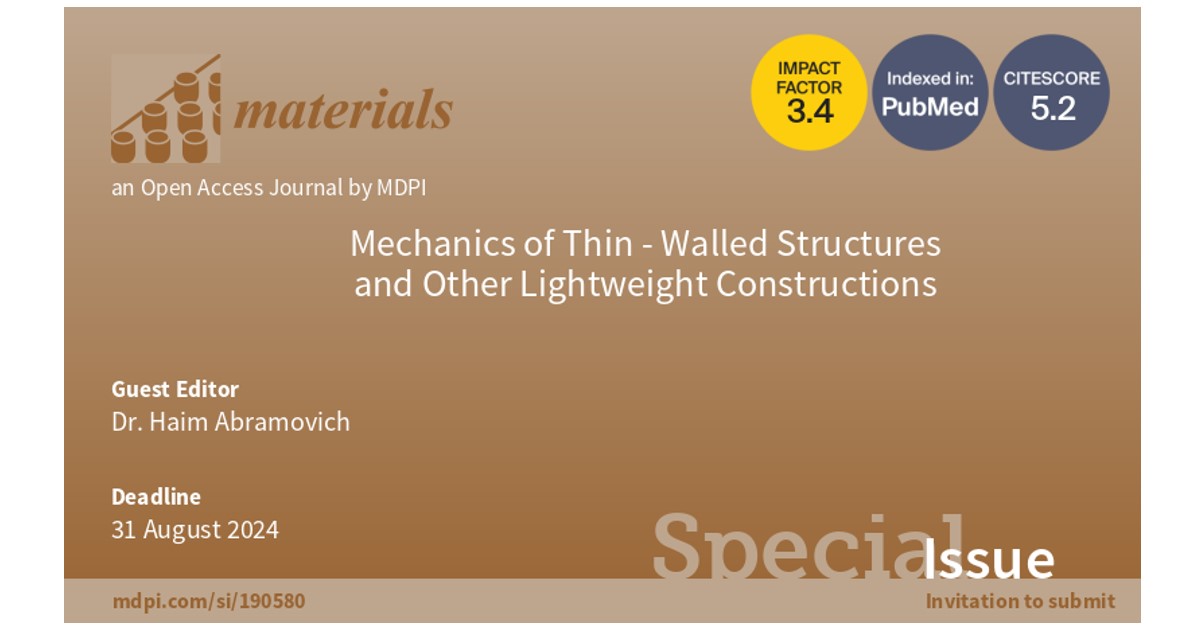Mechanics of Thin-Walled Structures and Other Lightweight Constructions
A special issue of Materials (ISSN 1996-1944). This special issue belongs to the section "Construction and Building Materials".
Deadline for manuscript submissions: 31 August 2024 | Viewed by 180

Special Issue Editor
Interests: stability of thin-walled structures; static and dynamic behavior of thin-walled structures; smart structures; piezoelectric materials; shape memory materials
Special Issues, Collections and Topics in MDPI journals
Special Issue Information
Dear Colleagues,
The topic for this Special Issue is “Mechanics of Thin-Walled Structures and Other Lightweight Constructions.” Thin-walled and lightweight structures must provide operational demands and safety within a minimal weight. Typical structures would be made of thin load skins’ frames, stiffeners, and spars, all made of high strength and stiffness materials to comply with the desired minimal weight criteria. Although the topic was extensively presented in the literature, new and innovative studies on non-linear behavior as compared to their linear behavior started to be more and more present.
The present Special Issue aims to provide a new platform for recent studies on the structural behavior of thin-walled and lightweight structures in their linear and non-linear regimes.
These studies can present those structures' static and dynamic behavior, highlighting new numerical methods, finite element solutions, and experimental results.
Prof. Dr. Haim Abramovich
Guest Editor
Manuscript Submission Information
Manuscripts should be submitted online at www.mdpi.com by registering and logging in to this website. Once you are registered, click here to go to the submission form. Manuscripts can be submitted until the deadline. All submissions that pass pre-check are peer-reviewed. Accepted papers will be published continuously in the journal (as soon as accepted) and will be listed together on the special issue website. Research articles, review articles as well as short communications are invited. For planned papers, a title and short abstract (about 100 words) can be sent to the Editorial Office for announcement on this website.
Submitted manuscripts should not have been published previously, nor be under consideration for publication elsewhere (except conference proceedings papers). All manuscripts are thoroughly refereed through a single-blind peer-review process. A guide for authors and other relevant information for submission of manuscripts is available on the Instructions for Authors page. Materials is an international peer-reviewed open access semimonthly journal published by MDPI.
Please visit the Instructions for Authors page before submitting a manuscript. The Article Processing Charge (APC) for publication in this open access journal is 2600 CHF (Swiss Francs). Submitted papers should be well formatted and use good English. Authors may use MDPI's English editing service prior to publication or during author revisions.
Keywords
- thin-wall structures
- lightweight construction
- sandwich panels
- fiber-reinforced polymer composite
- beams
- plates
- panels
- numerical analysis
- experiments
- displacements
- stresses
- boundary conditions
- linear behavior
- non-linear behavior
Planned Papers
The below list represents only planned manuscripts. Some of these manuscripts have not been received by the Editorial Office yet. Papers submitted to MDPI journals are subject to peer-review.
Title: ENRICHED DEFORMATION MODELS IN-PLANE AND OUT-OF-PLANE OF THE GEOMETRICALLY NONLINEAR SOLID-LIKE THIN-WALLED BEAMS
Authors: Kzam* , A. K. L.; Coda, H. B
Affiliation: Universidade Federal da Integração Latino-Americana
Abstract: The paper presents an original geometrically nonlinear formulation considering the improvements of cross-section buckling deformation to tridimensional model of thin-walled bars. The finite element kinematic is based on full Lagrangian descriptions undergoing large displacements and rotations. Both in-plane and out-of-plane cross-section deformation are included. Unconstrained vector, positions and cross-section buckling deformation are used as nodal parameters for a solid-like finite element. These parameters are called GDOF’s (Generalized Degrees of Freedom) and represent the intensity of energetic-conjugated forces derived from stationary energy principle. GDOF’s are an alternative to the linear buckling modes. Applying GDOF formulation is possible to consider a nonlinear cross-section buckling deformation and post-buckling analysis. General illustrative numerical examples are solved to demonstrate the accuracy of the proposed formulation.
Title: The Effect of Velocity Modifications on the Crashworthiness of Thin-Walled Structures
Authors: Michał Rogala; Jakub Gajewski
Affiliation: Lublin University of Technology
Abstract: Thin-walled structures serving as an energy absorber are widely known and used especially in the automotive industry. The study of thin-walled structures under dynamic loading deforms in a specific way. The forming plastic hinges and the accompanying dynamic response is related to the way the structure is loaded. Dynamic impact causes the occurrence of several phenomena affecting the formation of folds. The phenomena accompanying the crush are the occurrence of a shock wave or strain rate that defines the mode of plastic deformation of the material at the location of plastic hinges. The described phenomena affect the dynamic response of the structure in the form of a force-shortening curve on the basis of which unified crush efficiency indicators are determined. Due to the significant number of studies on energy absorbers implemented under static or quasi-static loading conditions, this article presents the effect of changing the kinetic energy components on the obtained crush efficiency indicators. The results presented represent experimental tests as well as nonlinear numerical simulation for 11 different initial conditions of the crashworthiness analysis. The realized tests showed a significant effect of changing the velocity and mass of the striker on the acquired results. The nonlinear effect of the change in the velocity of the tup with reference to the peak force and total efficiency was evidenced.






